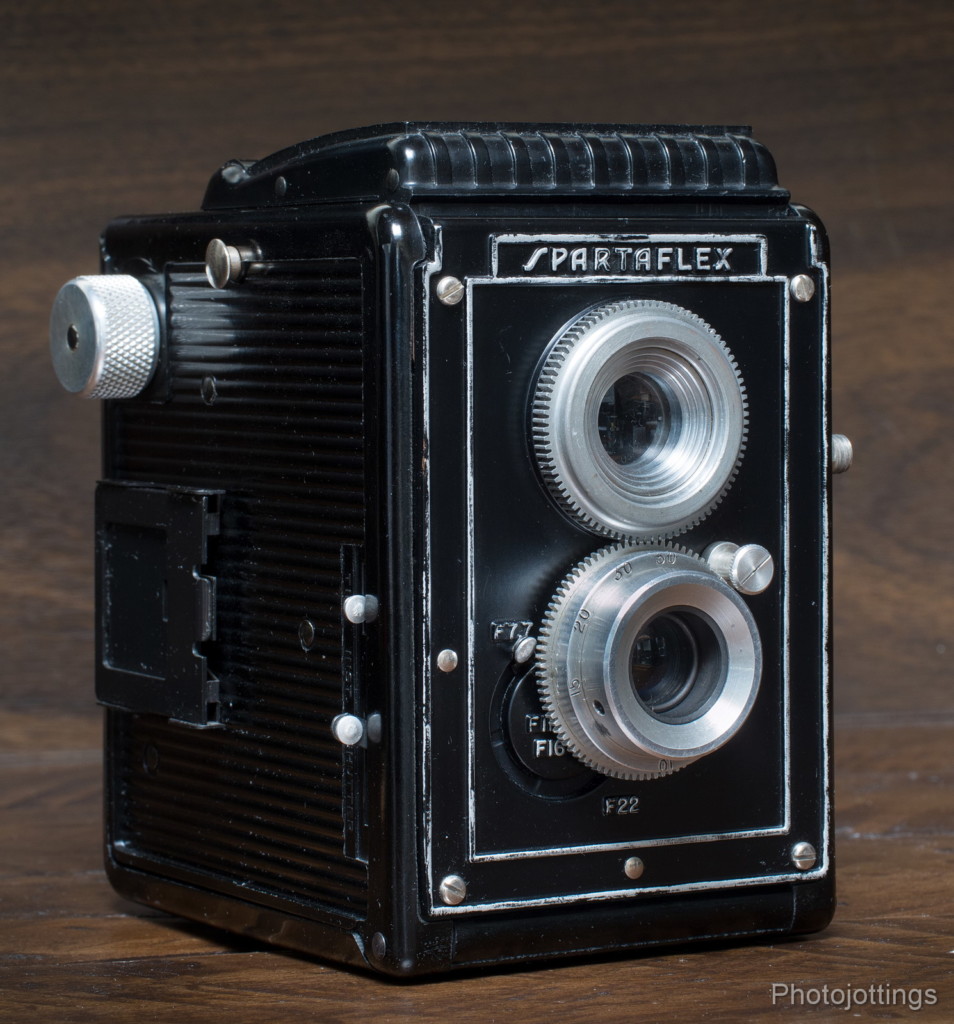
Our next camera up for review is the Spartus Spartaflex, where their famous marketing line is “you see the picture before you take it.” Of course all cameras have some sort of way to view the picture before you take it, but Jack Galter of the Spartus Camera Corporation was not shy about questionable marketing, and he even tried to register the name “Kodak” for his new line of cigarette lighters with the US Trademark association.
This item was yet another ebay impulse buy, and fortunately I got lucky and ended up with a nice working copy. The Spartus Spartaflex was made in Chicago Ill, around the late 1940s to early 1950s and priced at $27.50 with flash in 1949. When looking online for more info, I noticed it looks like there are at least three different iterations of this model through the years; the differences are mostly in the face plate and lens shapes and finishes.
The Spartaflex is a relatively well build plastic “box” type camera, with a waist level viewfinder and a coupled taking and viewing lens, which, by the way, means this is a real twin lens camera, not a pseudo type like this one. You can actually see the focus change in the finder as you move the lens in and out, but getting perfect focus is another story since there is no magnifier to use on the unusually dim ground glass. It uses readily available 120 film, and takes 12 6×6 pictures per roll.
Spartus made some pretty dubious claims when marketing this camera. For instance, in period magazine ads, they claimed the taking lens is coated, the metal parts are chrome, the focal length is 100mm and it focuses down to 5 feet. Based on my own inspection, none of those claims are true; but oh well, it sounds cool in the ad right, and who’s going to know? Sneaky those wretched marketers.
Some of these cheap old cameras with simple lenses are capable of producing pretty good large prints. When I decided to purchase it, I hoped that it would be much better than this similar one. To find out if it met my expectations, go to the bottom of the review; but first off, let’s take a look at the camera specs.
Name; Spartus Spartaflex
Manufactured by; Spartus Camera Corp, Chicago, Ill, USA.
Date of manufacture; not sure, but most likely in the late 1940s or 50s.
Price; a 1949 magazine ad shows the camera with flash attachment for 27.50, so probably over $20 for the camera body only. Current eBay prices range anywhere from $10 to $50 for the outfit depending on condition.
Build material; mostly black plastic, with a die-cast front fascia. All silver items are metal.
Weight and size; camera only, 19.6oz (555g)
Dimensions; camera only, excluding protrusions; 3.0″ (76mm) wide, 4.75″ (120mm) tall, viewfinder hood closed, and 4.0″ (101mm) deep.
Focal length; owner’s manual states 100mm, but really near 90-95mm, which is still very ‘long’ for this format, and in the telephoto range. A normal focal length for this 6×6 format is 75-80mm.
Aperture; four to choose from, 7.7, 11, 16 and 22, selectable via lever on the side of the taking lens.
Focusing distance; Manual states from 5′, but the lens is marked 8′ (2.5m) to infinity. Marks at 8, 10, 15, 30, 50 feet and infinity.
Original print size; standard oversize prints 3½” x 3½,” at this size any aperture used will look excellent. Today you’ll most likely get 4″ x 4″ and they look great too.
Approximate resolution; will make excellent 8″x 10″ prints when the aperture is set to F/22, and sharp 4″x 6″ at the widest aperture. See Sample images at bottom of page.
Lens; looks like a three element achromat for the taking lens, and probably a one or two element uncoated viewing lens. Maybe just a hint of blue on the taking lens, otherwise there’s no other effective coating or ‘color correcting’ nonsense present.
Shutter and speed; self-cocking (as you press), spring loaded rotary shutter. Shutter speed tested, and averaged about 1/45th second. Time and instant settings, but time acts as bulb, and holds the shutter open for as long as you press down the lever.
Distortion; I didn’t notice much when I took a really bad shot of a straight roof section. I think it was mild to moderate pincushion.
Color fringing; not much noticeable from looking at one roll.
Features; four apertures to choose from, real twin lens focusing as the two lenses are gear coupled. side mounted ‘sport finder,’ and uses commonly available 120 film.
Film; 12 6x6cm or 2¼”x2¼” exposures with 120 film, B&H, Amazon, eBay.
Double exposure prevention; no, so don’t forget to advance the film after you take a shot.
Accessories for this model; flash unit, and carrying case.
Crippling features and omissions; the shutter speed is too slow for me, about half my shots showed signs of jitter, and unfortunately there is no tripod socket. Viewfinder is dim even in good light. Additionally; In this price range they should have included a tripod socket and double exposure prevention.
Good features; four apertures to choose from, and it takes widely available 120 film. It’s reasonably well made with a simple build design, so it should work properly after all the years with zero maintenance or fuss.
Go here for the owner’s manual, and make sure you tip the site owner.
Product shots with descriptions. Click for larger images.

The Spartus Spartaflex in the ready to shoot position. On the left side is a mounting screw and connecting pin for the flash unit. The silver knob on the top is for a neckstrap, which is long gone on this camera.

Here you can see the aperture lever and detents for F/7.7, F/11, F/16 and F/22. You can get a good view of the synchronized taking and viewing lenses via geared connection. The pin in the middle/right with the slot is the focus index mark; here it’s set at infinity. The lower lever on the left side, (right side as you hold it) is the shutter, you push it down and release it for instant 1/45 speed, or ‘time’ for bulb mode, in which you hold it down for a long as you need to for a correct exposure. Good luck doing this with no tripod socket. The lever above the shutter selects ‘instant’ or time exposures.
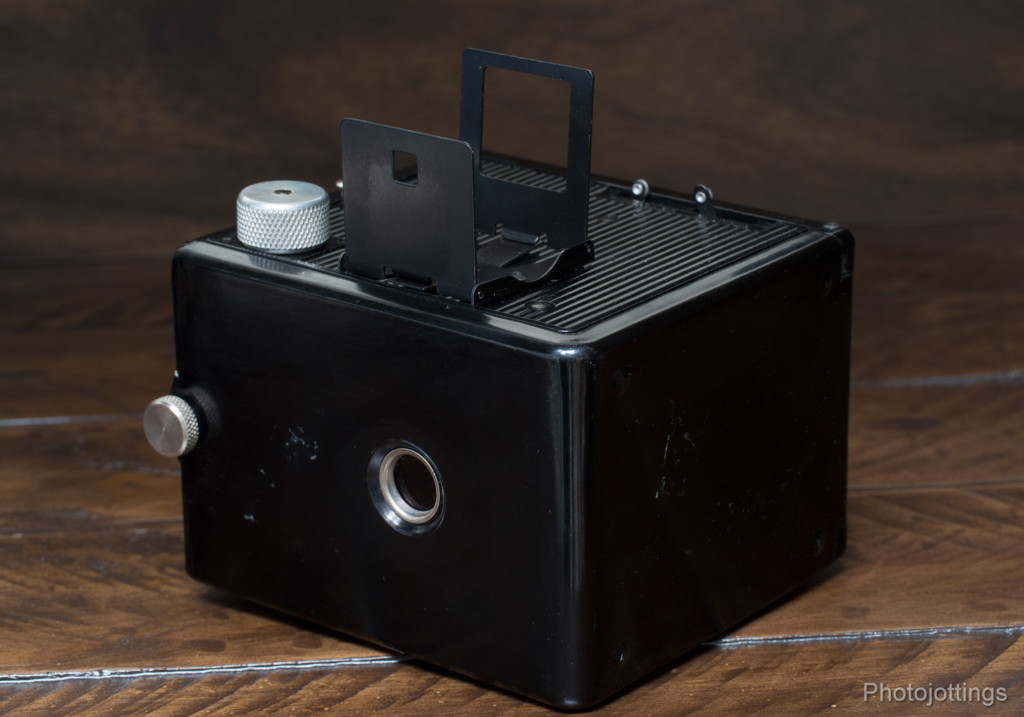
The flip up finder is on the side, just below the film advance knob. On the back is the red window for seeing the frame number. The back cover is secured by a knurled metal screw on top, or to the left in this picture.

Inside the cover you’ll see the film gate guides, and fake pressure plate. I didn’t seem to have any problems with film flatness.

The Spartaflex next to a average sized 6×6 TLR or box type camera. The Spartaflex has the same outside dimensions as a typical 6×9 box camera.

Here’s a view through the dim waist level finder. The glass is clean, with just a few dust speckles here and there. This scene is in bright high noon sun lite, so you can imagine what an inside shot or cloudy day would look like through this. The viewfinder covers much more area than the taking lens, so beware when composing, you may lose some of your sky like I almost did in the test shots below.
Here are some test images scanned on a Nikon Coolscan 9000 ED. All are 3000 pixels square; there is no additional resolution from scanning at a higher sample rate. Click for larger images.
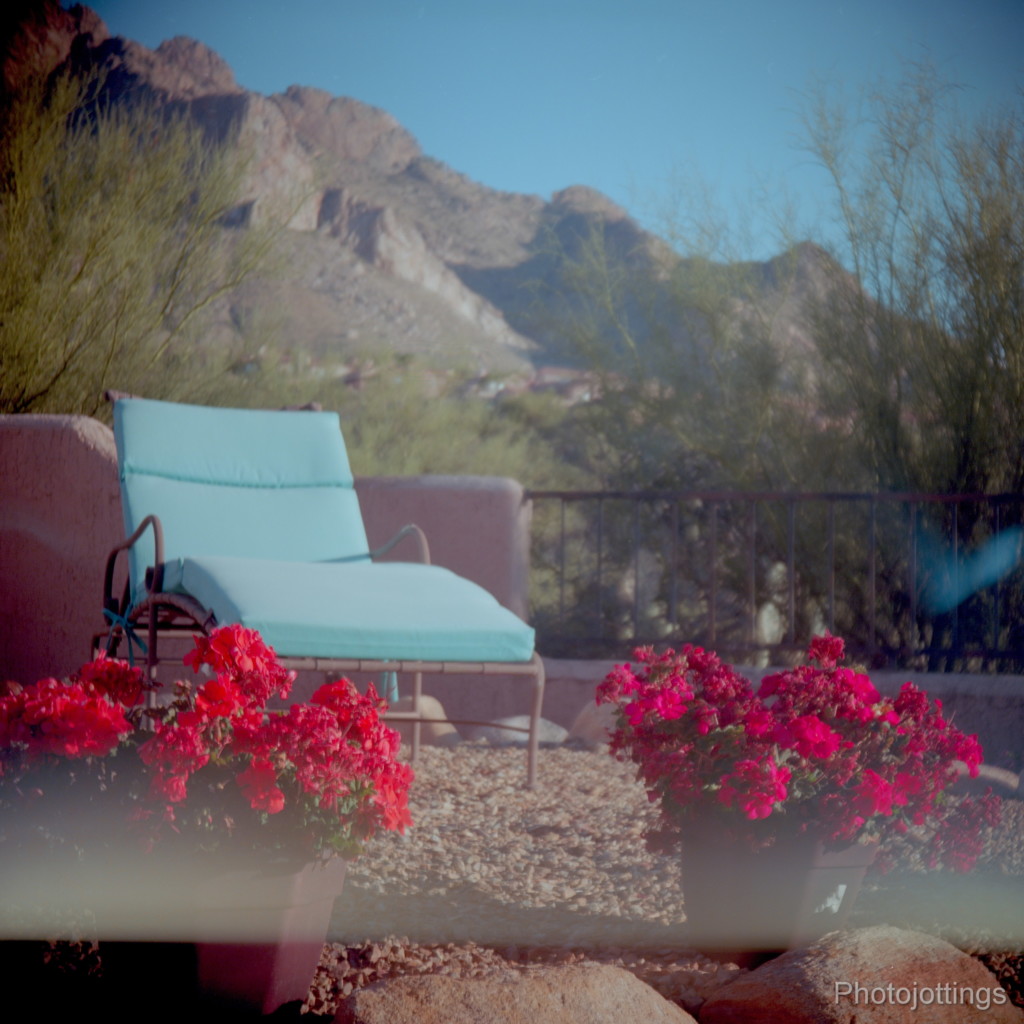
A close focus shot on the Geraniums at F/7.7. The amount of background blur is quite good due to the ‘long’ lens. The light band towards the bottom and the bluish spot on the right side appear on the first and last images on the roll. I suspect the processing lab, but I’m really not sure.
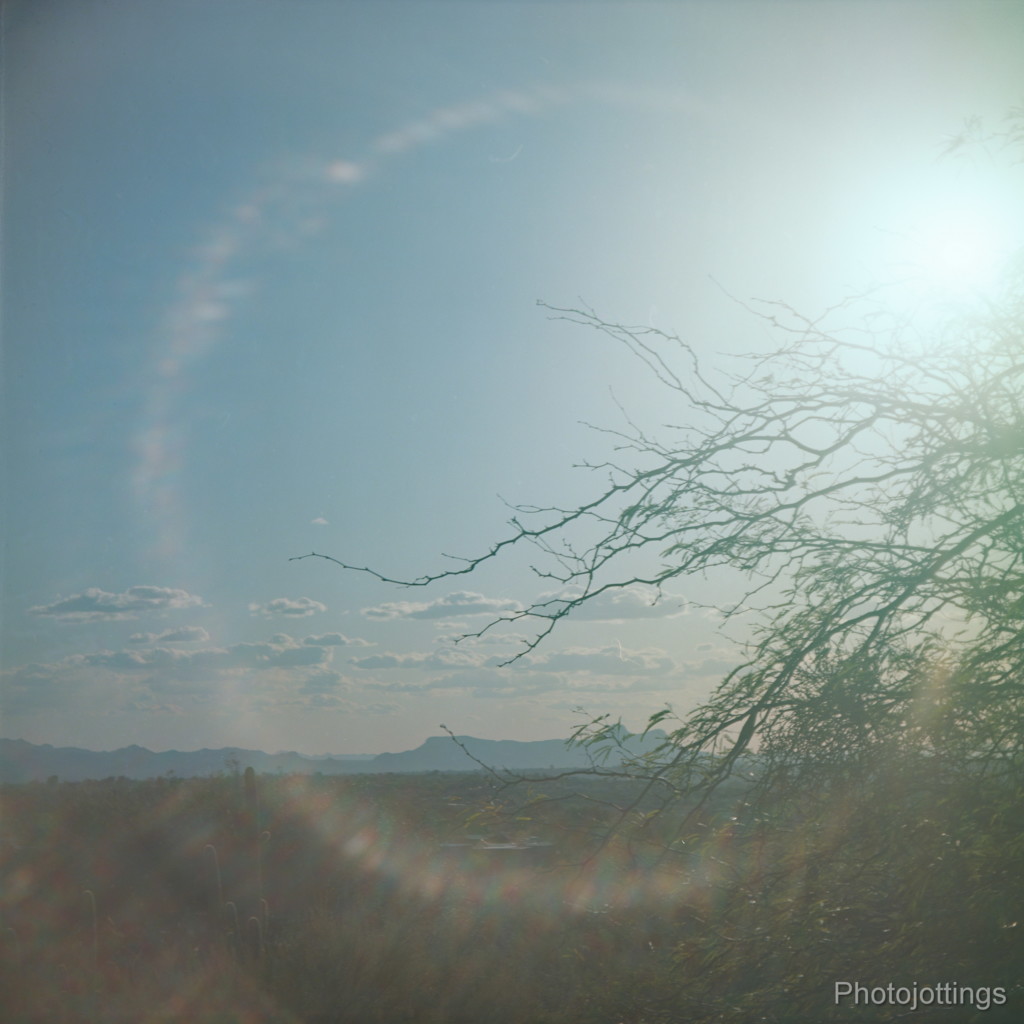
With the sun inside the frame you’ll get a big ring with rainbow flare; a very common problem with this type of lens.
Test samples at each indicated focal length. Click for larger images.
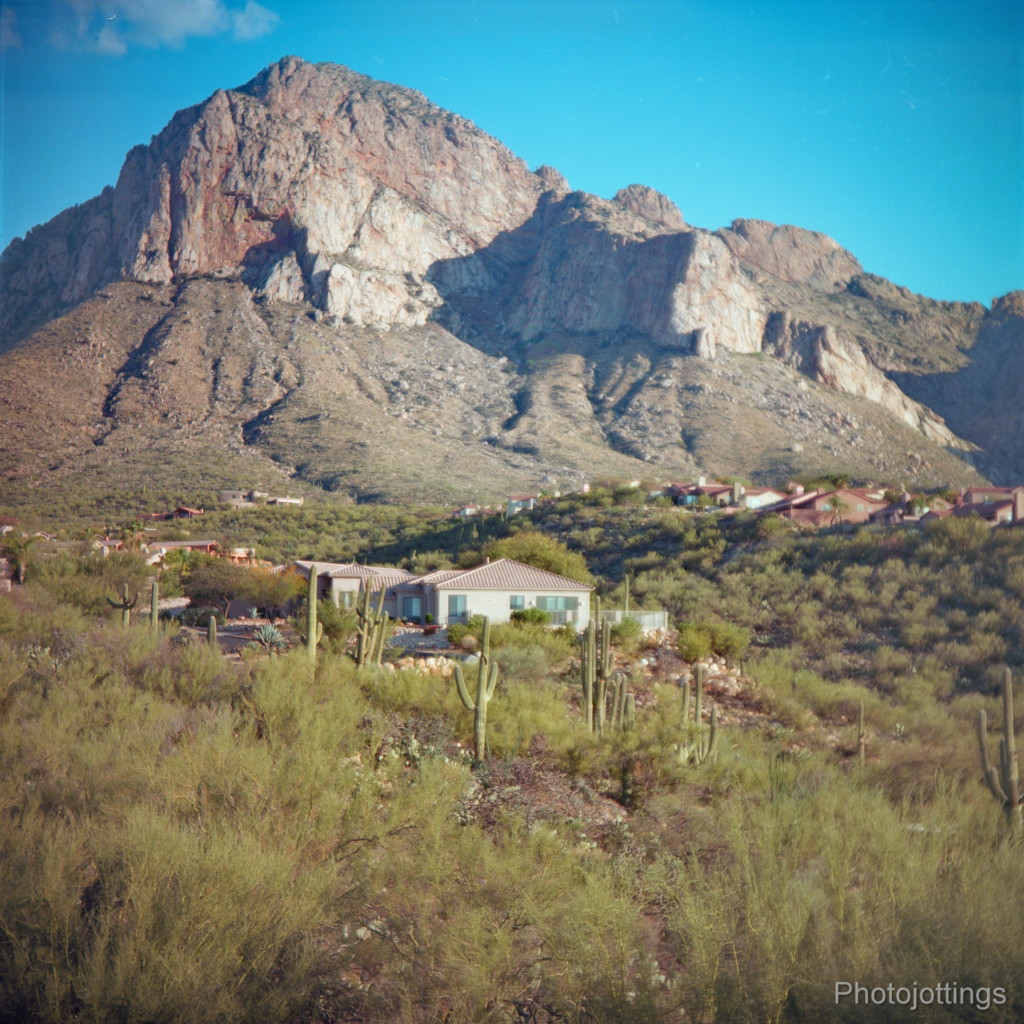
This shot is at F/7.7. The centers are pretty sharp for an achromat lens wide open, although I do see a lot of veiling haze. The soft right side is noticeable here.

Camera shake is noticeable in this image at F/11. There’s much more contrast at this aperture.
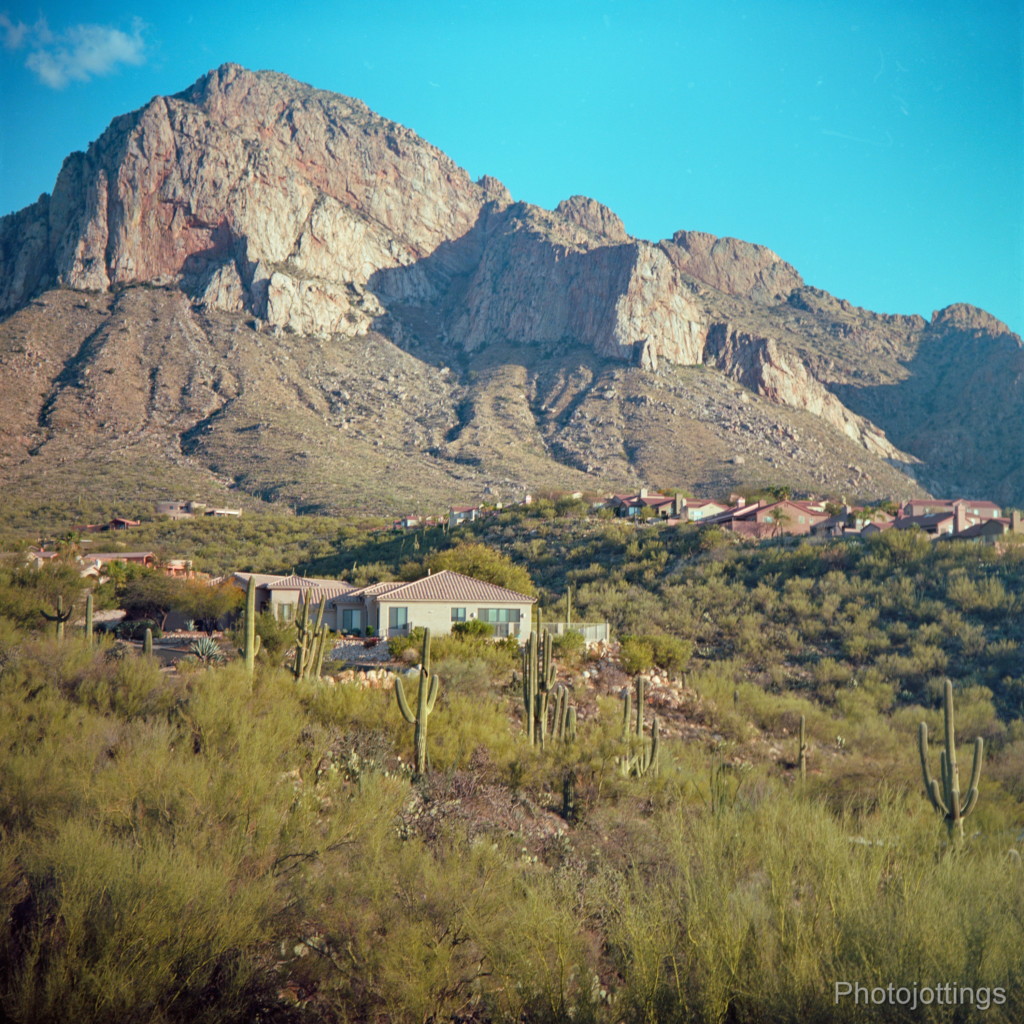
Another picture with camera shake, this one is at F/16. Now the sides are getting sharper, with even more contrast.

At F/22 the sides are sharp, and the contrast is quite good. You could make a large print from this picture, but why? it’s just a test shot.
Conclusion.
The Spartus Spartaflex is probably not the best ‘box’ type camera out there. I do like the image quality when stopped down, it’s really very good for the price range. It’s nice to be able to select four apertures, and it helps out in low light or when the lens is not centered correctly you can stop it down to F/22 for sharp shots by way of depth of field. My copy has some issues with a soft right side, but that’s somewhat common with cheaper cameras like this. The viewfinder is pretty dim, and it’s hard to see the subject in all but the brightest light; although it seems to be bright enough to show when the focus is close, however, it’s not easy to see dead-on results as there is no magnifier as you would get on a more expensive TLR camera.
Just a thought here: I’d like to point out that it seems the Spartaflex was possibly designed as a 6×9 camera, instead of 6×6. I’m thinking that because of the size of the camera, and focal length. The image capture area really falls in the telephoto range, and this is the only 6×6 camera I’ve ever seen with a lens this long; claimed 100mm but more like 90-95mm. When you consider that, and the viewfinder covers about 75mm, you can easily come to the conclusion that the Sparteflex was initially designed for 6×9 images like their “Press Flash.” Maybe they ran into some problems along the way, and production costs started going up, so they decided to use parts they already had available for their other 6×6 cameras like the “Full Vue” etc. Or maybe their other 6×6’s had the same focal length, and I’m full of BS; the Spartaflex is the only one I’ve had a good look at.
My only real complaint with the Spartaflex is the shutter speed is just too slow for me; as I said earlier in the review, over half my shots showed some level of camera shake, and that’s not acceptable, especially when you can’t even mount the camera on a tripod. Funny, but the Ansco Color Clipper has almost the same shutter speed and weight, and I only had one jittery shot for the roll; but I guess it’s in the position of the shutter button and the way you hold it.
Anyhow, it was fun to shoot a roll of film through this camera, but it’s one and done for the Spartaflex. For the price range, I’m giving it two thumbs up for image quality, and two thumbs down for shutter speed and viewfinder brightness. If you really want to screw around with this type of camera, I’d get the Kodak Duaflex with Kodar lens, I reviewed it here, and liked it quite a bit, it has a much wider lens than the Spartaflex, a brighter viewfinder, and seems to produce the same images. The only thing is it takes 620 film, which is still available fresh, but pricey.
I used Kodak Ektar 100 because I had some that was about to expire and wanted to use it up, however, for best results, I’d use ISO 200-400 speed film, and keep the camera at the F/16-22 setting.
Please consider buying your goodies through my links, doing so helps support the site, thanks!